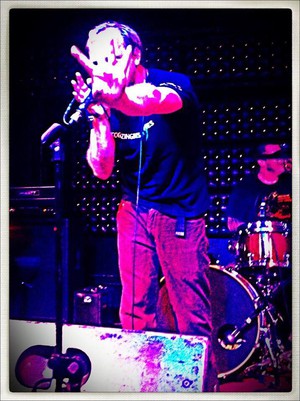If I told you a film called SOMETIMES I THINK ABOUT DYING is a comedy you might have trouble believing me, and that’s fair. The film, directed by Rachel Lambert, is funny, but not in its own way - a personal, rewarding, and knowing way. It’s an aperitif best ingested by the anxious, the mildly despondent, the obscure. If you’ve ever felt disjointed, disillusioned, or a melancholic spirit in an ill-fitting skinsuit, this movie just might be for you.
The film stars Daisy Ridley (STAR WARS VII-IX) as Fran, a dormouse in a puffy coat, who works in an anonymous office, seemingly anonymously, and daydreams about the peaceful release of eternal sleep. She is pulled from her fog momentarily by the arrival of new officemate Robert (Dave Merheje) and soon finds her small world exploding with social entreaties that threaten her carefully curated seclusion. The film is achingly beautiful while also overarchingly funny to viewers who understand Fran’s world a little-too-well. Parvesh Cheena plays an officemate of Fran’s who parades vegetarianism for no other reason than carrying forth an offhand lie he told once. It’s funny because it’s not. It’s understated, as much of the film is - it’s here and then it’s gone, but you’ll find your thoughts returning to the narrative for days afterward.
Lambert has crafted a film that rewards the invested viewer, paying dividends in secret answers to dialogues created between the two. At one point I asked myself if Fran had any pets or living things to care for, and one frame later I spotted a plant that had never been shown before. It’s as if the storytellers know exactly how you’ll respond to the story as it unfolds, and they’re there to meet you every step of the way. Lambert, along with DP Dustin Lane, illustrates Fran’s quiet isolation in blue tones of the Oregon coast as though they were painting an album cover for your favorite shoegaze mathcore drone masters.
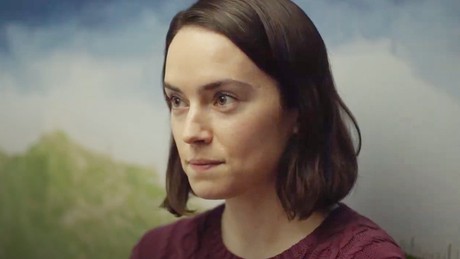
I liked the film so much that I dove into its entire backstory, all the way back to its original staging as a play called Killers in 2013 in my old stomping grounds of San Diego, California. The original play, written by Kevin Armento, shares less than 49% of its DNA with SOMETIMES I THINK ABOUT DYING, a short film co-written by Armento and Stefanie Abel Horowitz, director of the stage play and the short film, starring the original actress from stage Katy Wright-Mead. These three would come together to write the feature-length script that became the film that releases today. Killers wraps up its story in an ouroboros which might seem tawdry on screen but offers much more insight into the thoughts and fantasies of its nameless character who emerges in the films as Fran. Gone are the interesting characters Miranda, Julia, and Bobby (mostly) in the film version, and I beseech those with any interest in these films to seek out Armento’s original script.
The film takes a surprisingly life-affirming stance by contrasting Fran’s frequent maudlin escapes with that of her officemate Carol (Marcia DeBonis), who is retiring to go on a cruise. When the two reconvene toward the end of the film, Carol’s plans have gone awry, and it offers a terrible irony to Fran - that you can fantasize about dying and not or you can fantasize about living and not. Either way, life is what happens when you’re busy making plans, so you might as well live it.
I couldn’t wait to chat with director Rachel Lambert (IN THE RADIANT CITY) about this devastating yet accessible character study and the community of collaboration that brought it to life.
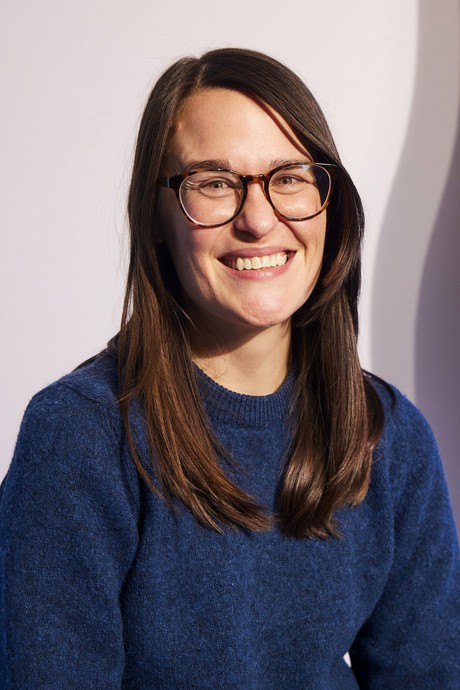
Eric McClanahan - So we’re talking about SOMETIMES I THINK ABOUT DYING which was at Sundance last year. What was that experience like?
Rachel Lambert - To be in main competition was incredible, and we also played on opening night, which was only a little pressure. [laughs] It’s a high honor and I felt a great deal of responsibility that night. I’m always nervous when I screen, but I was even more nervous because I so wanted to do right by Sundance and make sure that I was part of a very positive and exciting opening night. I thought “Oh God, I hope everybody likes it so they’re happy they gave us that slot.”
EM - So how did you come aboard this feature-length production?
RL - Well, the script was sent to me by my producer Alex Saks in November 2020 and I loved it, to which she said “That’s great, because you’re the only person we sent it to.” She was indicating that I was the person she wanted to do [the film] so that was great. The first conversation we had about it in terms of its life and how we put it together was I said I think this should be Daisy Ridley’s part. So went to Daisy immediately and she said yes immediately so the three of us sort of banded together from day one and said “okay, let’s get this made then.” And because it was Alex Saks it got made within the year. [laughs]
EM - I saw that Daisy Ridley is a producer on this film, so obviously she really believes in this property. What was your collaborative relationship like in making this picture?
RL - It was wonderful. She was, I think, instrumental in our thinking through our plan but we also all understood each other’s strengths throughout and knew whose voice should carry in different moments; I think there was always a lot of mutual respect. I worked very hard to give Daisy everything I could and talk to her before we shot so that hopefully when she got to set she could feel like an actress as much as possible and be an actor first. I wanted her to not have to feel like she was holding too much or carrying too much water. There were obviously things that we’d have to rally and have chats about through the production process but she certainly has reported, through press for this film particularly, that she felt that she was able to focus as an actor through the production part of the process and I’m happy about that. So basically, it was about knowing when certain people need to step into certain roles at different moments and there was certainly a lot of trust and respect the whole way through and that’s incredible.
EM - How involved were you in the development of this story as a feature-length film? I say this because I dug deep into this project, because I liked the film so much, and I reached out to Kevin Armento and got the script for the original stageplay Killers, on which this story is based, and I watched the short film by Stefanie Abel Horowitz [which went to Sundance in 2020], so when it came time to make the feature-length there were multiple avenues to extend the story. How involved were you in bringing the Office into the main part of the story.
RL - Well the authors of the script are playwrights - they write for the theater, first and foremost, so when I got the script there was no visual data in the script. I asked them what work the office did and they said “What do you think? You’re the director.”
[In Armento’s stage script, “Fran” actually says “I could tell you what my company does but would it matter? I mean, would it in any way affect your perception of Who I Am?”]
I said “Yeah, you’re right!” There was such an invitation on the page to participate and invent and fill. They really created a document that I recognized as someone who also began in the theater. So I kind of took it in that way, of saying I have to justify this, to create this space, to build the world, as if I was mounting a play. Now, though, I have the opportunity of cinema to do so, not just the confines of a proscenium. So with the physical office, a lot of that began with me finding the town and then finding the office, and deciding what goes on in there, what that office was. So putting that physical world together gave me some of the finer, soft tissue elements of what this world is in the office, as well. In terms of capturing the office, Dustin [Lane, Director of Photography] and I had this idea of capturing the intense minutiae from day one, to put a lot of focus and attention on these beats, and the humor was present to me on the page. We had a lot of voiceover in the script from beginning to end, so I knew where a lot of the humor was coming from, so I had a permission slip to have a humorous tone. My sense of humor is very dry and awkward and cringy and strange, so to me it’s hilarious to have someone just sort of talk about an HDMI cable, and the bizarreness of that conversation and how it can kind of become emotional, though you’re just looking for a cable - that sort of thing cracks me up. Because that’s who we are, that’s what human beings do, we’re just such a silly animal, so that was all that went into taking the page to the screen with the office.
EM - Now, I’ve been to Oregon, and it can be a beautiful place as well as terribly depressing. Was that a conscious choice? That “Well we need something that will envelop her in her own psyche… let’s go to Oregon!”
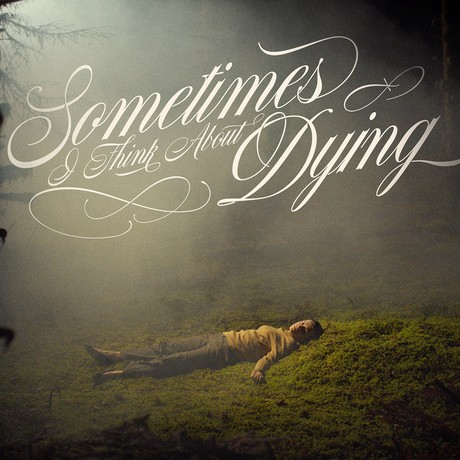
RL - Love the imagery you’re writing with the word “envelop.” Yeah, it was definitely written to be coastal, but it certainly isn’t Miami. [laughs] Not Miami, so I was actually having a conversation about that with Alex, debating where we wanted to go, and there was something about the sweep and the scope and the romance of the west that Oregon promised as a coastal area and also the tones visually. I’m very sensitive to color, almost like allergic, and the color palette of Oregon felt right for the tone and the atmosphere.All of those things felt good. I’d never spent any considerable time in Oregon so this was all on gut and then we went there and it was like OKAY, and then we found the town and said “This is the town!” Then I lived there in Oregon while I was prepping, because I like to live the movie before I make it, and I got the know the place and I hope I did it justice in terms of bringing it to life, that part of the world.
EM - I like that it opens with the deer in the town, in the human’s living space, just wandering out of place. Was that staged? Like was that a deer actor or did you capture that?
RL - We captured that. That was one of the days Dustin and I were out doing photography to find theme, find beauty, find the world, which we did for about four or five days, and these deer were everywhere in that town. You’d be gassing up and they’d cruise by, and I grew up around a lot of deer, so I know a bit about them. Like I know that they love to eat apples, because they would always eat from my parents’ apple tree, and we had all these apples from the opening shot with the apples gathered around the sewer drain, because they’d roll down the tree from when they’d fall. So when we wrapped that we both thought “Get them in the car!” because we both knew we’d find something poetic to do with them later, and so we used the apples as bait for the deer. I saw this one deer in a yard chilling by some stairs and I thought “Ooo, if I bait him apples near the stairs I bet we could get him walking down the stairs.” And I love that the walk is sort of a cowboy, western walk - there’s just something Western about it, and it was the West, so it totally connects! But yeah, we had a lot of animals play with us naturally, but they didn’t all make the cut. We had some elk that didn’t make the final cut, but oh well. But that deer did.
EM - Now speaking of the visual language of the film, the first couple of times that we see Fran in the office, it’s such a macro closeup that she literally doesn’t fit in the frame, mirroring how she doesn’t “fit” in the office. Tell me about those storytelling decisions.
RL - You mean like the fragments. Yeah, the fragments was part of that attention to what you’re touching, that minutiae, the way we might shoot someone in a scene is information. Like “it’s a woman at a chair at a desk.” Okay, but what’s the empathy of that scene? It’s about her hunch, about the way she touches her mouth, about that tickety-tack she does with her fingers. That’s what the moment’s about. So there’s that aspect of it but there’s also the aspect of when you’re feeling disconnected from your environment, when you’re feeling fragmented, perhaps, or disjointed, then it feels wrong to place her in the world in this perfectly composed sort of way. We get more of that towards the end because there’s an evolution of sorts, but yes, that was the thinking behind it.
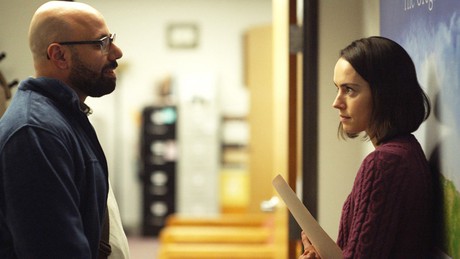
EM - So there’s a great scene toward the end where we see Carol [Marcia DeBonis], and I wrote in my notes “Carol - Sometimes I Think About Living.” Tell me about the inclusion of that reprise and how it shapes Fran.
RL - That was the one thing I got to change about the script. There were minute changes throughout, but previously there was no scene between her house and the office arrival with the donuts, and I said “I believe we need to understand why she’s making this choice. We need to understand what this choice is about, what her emotional motivation is, and carry that forward into the office with her. We need to be with her.” So we need to see her make the choice and see it crystalizing. We needed to see how she would make that choice but it wouldn’t be her articulating it, not only because that’s not how she would process a learning moment anyway. But I also thought this felt more right, because she’s in a receptive place. She’s finally gotten up off that floor, she is kind of empty and looking to be filled, and in conversation with Alex and Kevin we felt that Carol was the right person to be built up and given a resonant echo from the beginning to the end with that character. Then I was given permission by the writers to write that scene, so the things that Carol says in that scene are very personal to me. It’s the one moment in the film that I get to speak, in a way, and maybe that’s not cool. Maybe I shouldn’t have done that but I felt right; I’m proud of that moment. I think it works, and the phrase “It’s hard being a person” is something that was told to me by an old friend and it’s since become my mantra in a way. I think about that a lot and it’s something that I give myself and I wanted to give it to other people.
SOMETIMES I THINK ABOUT DYING premieres in theaters today, January 26, 2024.
Until next time, stay safe and stay sane.
-McEric-
aka Eric McClanahan
